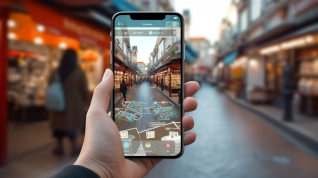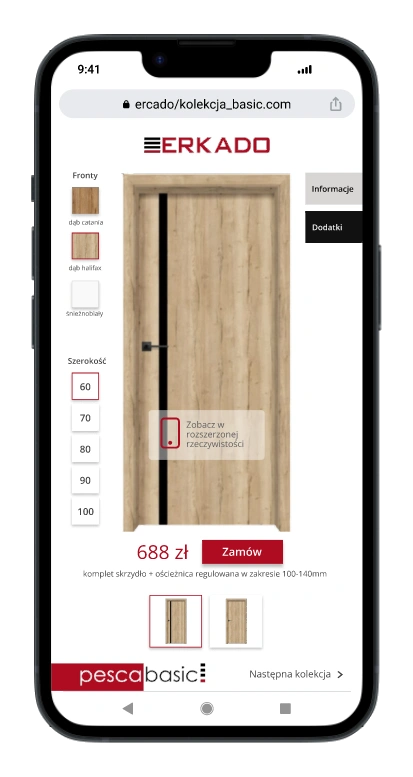Planning Your AR marketing campaigns

Augmented reality (AR) has become a powerful tool in the hands of marketers, enabling the creation of memorable, interactive experiences for customers. Planning marketing campaigns using AR opens the door to extraordinary personalisation and engagement. In this article, we will explore how to harness the potential of augmented reality in marketing strategies and how it can revolutionise the way brands communicate with their customers.
Understanding augmented reality and its marketing benefits
Augmented reality is a technology that superimposes computer-generated images onto the real world, thus creating an interactive experience for the user. In recent years, AR has been a growing trend, particularly, in marketing (You can read more about this in the post titled AR in marketing on our blog).
It provides companies with a unique opportunity to interact with customers by creating immersive experiencesthat can be accessed with smartphones or other devices with a built-in camera and Internet access. Using AR, marketers create more interactive and engaging experiences for their customers, leading to increased brand awareness and customer loyalty. AR integrates digital content with the real world, improving the user's perception of reality.
What are the advantages in question?
There are many benefits of using AR in marketing as it creates incredible advertising and promotional opportunities. It enables companies to create interactive experiences that can be tailored to the individual user. For example, through the 3D configuration, the customer can visualize a sofa model comparing different sizes and colours, and then using augmented reality supported by their smartphone, they can 'try it on' in their living room. This leads to increased customer satisfaction and higher conversion rates. AR can also be used to collect data on customer behaviour and preferences. This data will be used to improve and plan company marketing strategies in detail.
See also: how much does AR cost?
Examples of successful AR campaigns in marketing
There have already been many successful AR campaigns. For example, an IKEA or Keda Furniture AR apps allow customers to visualise furniture in a real-world setting so they can see exactly how it would fit into their home before making a purchasing decision (You can see what this looks like in practice with our 3D product configurator ).
Another example is Pepsi Max AR campaign, which used augmented reality to create an interactive experience for customers by placing a virtual tiger in the middle of a busy street.
The Nike brand opted for an immersive logo that generates amazing real-time animations when you point your phone camera at it. These examples demonstrate the potential of AR in creating unique and memorable customer experiences, leading to increased brand awareness and customer loyalty. As AR technology develops, it is certain that we will see even more innovative uses of AR in marketing. We are only limited by our imagination.
Read also: immersive VR training.
Creating an effective augmented reality marketing strategy
Integrating augmented reality technologies in marketing strategy is really a game changer. However, to create an effective AR marketing strategy, it is crucial to identify your target audience and marketing objectives. This will help tailor AR content to specific customer needs and interests. An AR marketing campaign that targets younger audiences should focus on creating interactive and entertaining content, while a campaign that targets professionals must focus on providing informative and educational content.
Engaging AR content
Creating engaging and interactive augmented reality contentis another key aspect of a successful AR marketing strategy. This might involve creating AR product presentations, interactive games or virtual tours of physical spaces. The key is to make the content immersive and interactive. It should encourage users to interact with the brand and its products in a funny and memorable way.
Integration of AR with marketing channels
A key aspect worth mentioning is the integration of AR into multiple marketing channels. This can include integrating AR into social media campaigns (posts and ads that generate augmented reality effects), email marketing (sharing links or QR codes to AR models) and even physical advertising. By integrating AR into multiple marketing channels, a company reaches a wider audience and provides a consistent brand experience across all touchpoints. In addition, companies can track the effectiveness of their marketing campaigns and make data-driven decisions to optimise strategies to maximise impact.
The See My Model platform not only provides insight into the number of model views but also their geopositioning, as well as preferred viewing times – find out more about our AR technology and 3D product visualisation today.
Overall, a successful AR marketing strategy requires a thoughtful approach that takes into account the target audience, marketing objectives, engaging and interactive content and integration across multiple marketing channels.
Stages of AR marketing campaigns
- Identify the campaign goals
The first step is to establish the goals we want to achieve through an augmented reality advertising campaign. Answer the question: Do we want to increase brand awareness, increase sales, acquire new customers, or something else?
- Define the target group
MWe need to define exactly who we want to target with our campaign. For an augmented reality advertising campaign, we need to consider which user groups are most interested in this type of technology.
- Choose the platform and tools
The next step is to choose the platform and tools to be used in the advertising campaign. In the case of augmented reality, these can be different types of applications, software or special devices.
- Create the campaign
The next step is to create a creative and effective advertising campaign to be used on the chosen platform. The campaign should be tailored to the target group and take into account the goals we want to achieve.
- Launch the campaign
The final step is to launch the campaign and monitor its effects. It is important to constantly analyse the results of the campaign and modify it if necessary to achieve the goals.
Read also: AR in the manufacturing industry.
Measuring the success of augmented reality marketing campaigns
One effective way to measure the success of these campaigns is to set measurable goals and metrics at the beginning of the campaign. These goals and metrics should be specific, measurable, achievable, relevant and time-bound (SMART) to ensure they are realistic and can be effectively tracked.
Tracking and analysing user engagement is key to planning. By monitoring user engagement metrics such as click-through rates, time spent on the AR experience and social media shares, marketers can gain valuable insight into how customers are interacting with the AR content they design.
Adapting and refining an AR marketing strategy based on results is the final step in the effective use of AR in marketing. By analysing the data collected during campaigns, marketers can identify areas for improvement and make the necessary adjustments to the AR experience. This iterative approach to the strategy testing and improving leads to greater customer engagement and, ultimately, better business results.
Do you like the post? Share to others!

Krzysztof Basista
COO
For years, he has been involved in AR / VR projects ranging from entertainment to heavy industry. Always looking for problem solving through technology.
Contact us
Related posts

Augmented reality (AR) is no longer just the domain of games and entertainment - it is now increasingly making its presence felt in tourism...

Have you wondered what it would be like if the boundaries between the virtual world of games and reality began to blur? In recent years...

Augmented reality (AR) is increasingly boldly entering the classroom, offering new, interactive teaching methods. It transforms...

The Metaverse is a concept that is increasingly emerging in discussions about the future of technology and the digital world...

In an era where efficient, effective, and engaging training is integral to a company's success, many are turning to emerging technologies for solutions...

It is a powerful tool for presenting complex 3D models in a friendly and intuitive way. With the right techniques, you can easily visualise...






